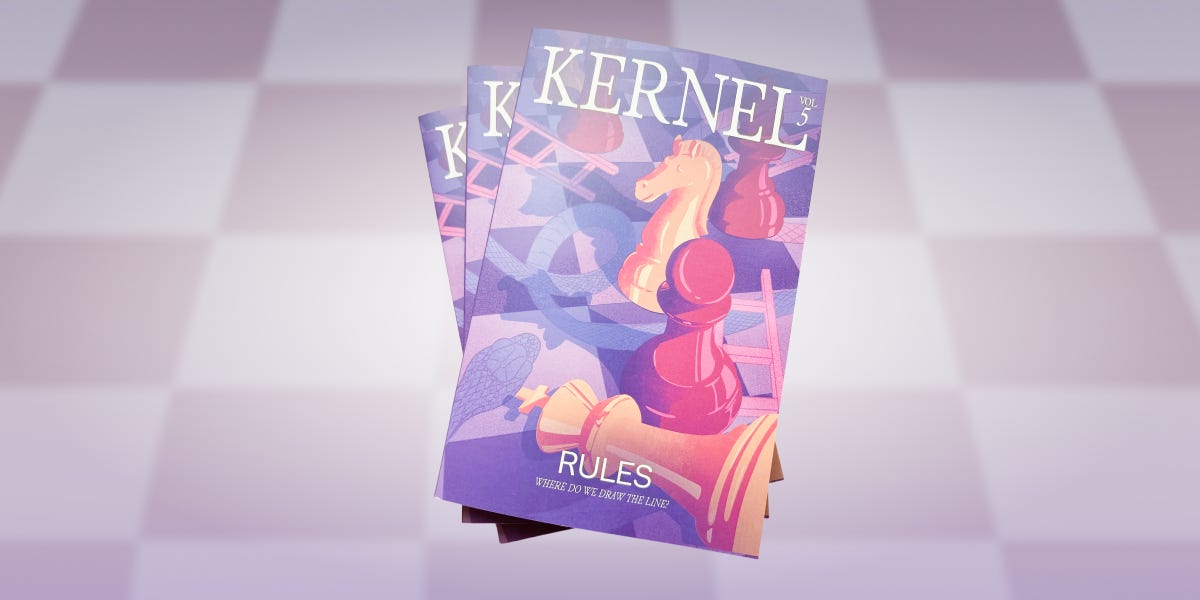📏Where do we draw the line?
Kernel Magazine Issue 5 is out now — read the editor's note and get your copy now!
Kernel 5 is live now!
Come to our SF Launch Party at Gray Area on July 17 — tickets are going fast!
This week, we are officially releasing Kernel Magazine’s fifth issue, themed around rules! To introduce you to the issue, our very own has written an editor’s note — a sort of set of rules for Rules:
✍️ Editor’s Note
by Kevin Baker
Rules are the invisible architecture of social existence. Some boundaries they create are porous and negotiable, others rigid and absolute. Lines on a map transform empty space into property, into nations, into contested territories. Lines of code transform possibility into permission, into prohibition, into the parameters of digital life. Lines of conduct transform strangers into communities, communities into hierarchies, hierarchies into systems of belonging and exclusion. Natural as they may seem, these boundary-making practices—whether physical, digital, or social—are human constructions, continuously maintained through practices that render them seemingly inevitable, intrinsic, and reasonable.
Rules vary in character. As historian of science Lorraine Daston observes, rules can be thick or thin in their formulation, flexible or rigid in their application. Thick rules anticipate variation and complexity, embedding context and viability in their structure. They invite discretion and adaptation as circumstances change, like common law systems that evolve through interpretation and precedent. Thin rules, by contrast, implicitly assume a predictable, stable world, applying the same logic regardless of context. Most algorithmic systems embody thin rules—standardized, consistent, and ill-equipped to handle exceptions or edge cases. The tension between human discretion and algorithmic consistency, between rules that bend and rules that break, is one that defines our technological moment.
The most consequential rules may be those we’ve incorporated into our sense of self and reality so completely that we no longer recognize them as constructed. We come to embody these boundaries, experiencing them not as external impositions but as natural facts about the world and ourselves. It's primarily at moments of breakdown or conflict—when we encounter those who operate under different assumptions—that we glimpse how deeply these organizing principles shape not just what we can do, but how we understand what is possible or reasonable in the first place.
This fifth issue of Kernel examines the boundary-drawing processes that structure our technological existence. Our Regulation section investigates how judgment becomes encoded into digital architectures that increasingly mediate social and economic life. These systems, despite their technical appearance, embody specific worldviews and priorities. Meanwhile, our Generation section interrogates how creative practices and expressive possibilities emerge within and against prescribed constraints, exploring how technologies both limit and expand the territories of human expression.
Across these investigations, a consistent pattern emerges: rules function not merely as instruments of control but as metaphysical scaffolding that gives form to our reality. This is what “socially constructed” meant before the phrase lost its edge and became a dismissive synonym for fake: our reality, built through boundaries that, once established, vanish into the seemingly solid ground beneath our feet. The rules we construct create the conditions for certain kinds of actions and relationships while rendering others unthinkable. What initially appears as mere restriction thus reveals itself as constitution—the very framework through which reality becomes intelligible to us.
But architectural metaphors only capture part of the story. The lines we draw aren't mere inscriptions on a blueprint, but incisions into the social body. Each rule cuts through reality with a knife's edge, separating what's permitted from what's forbidden. These aren't abstractions but material interventions with real consequences. The lines we etch through code, policy, and practice don't merely divide existing categories—they create new ones, making certain modes of existence possible while rendering others impossible. As these incisions cicatrize, their origins as deliberate cuts fade from view. The rules appear inevitable, natural, reasonable. We forget they were drawn by human hands.
If these systems reflect choices rather than inevitabilities, how might we reimagine them? Rules, at their best, function not as rigid barriers but as dynamic frameworks that enable meaningful interaction. James Carse offers a valuable perspective by distinguishing between finite and infinite games—the former played for winning, the latter for continuing play. These approaches reflect fundamentally different orientations: one resembling the grammar of a living language that evolves to sustain discourse, the other like debate protocols designed to declare winners and losers. Games themselves express rule-based systems in their purest form, where boundaries create not just constraints but the possibility of meaningful action. The most productive technological boundaries might be those that invite ongoing participation rather than algorithmic conclusion. They evolve through use rather than reaching foregone outcomes.
When we treat digital systems as finite games with predetermined endpoints, we miss opportunities to create spaces where rules generate possibilities rather than terminate them. Perhaps what we need are fewer victory conditions and more conditions for continued play—not finite games with winners and losers, but infinite games where the boundaries expand with every move.
Where do we draw the line? And who is this “we”?
You can read Kernel at kernelmag.io. We’ll be sending more previews throughout this week — and if you’re in the bay, see you at Gray Area!
Until then,
The Kernel Magazine Team




